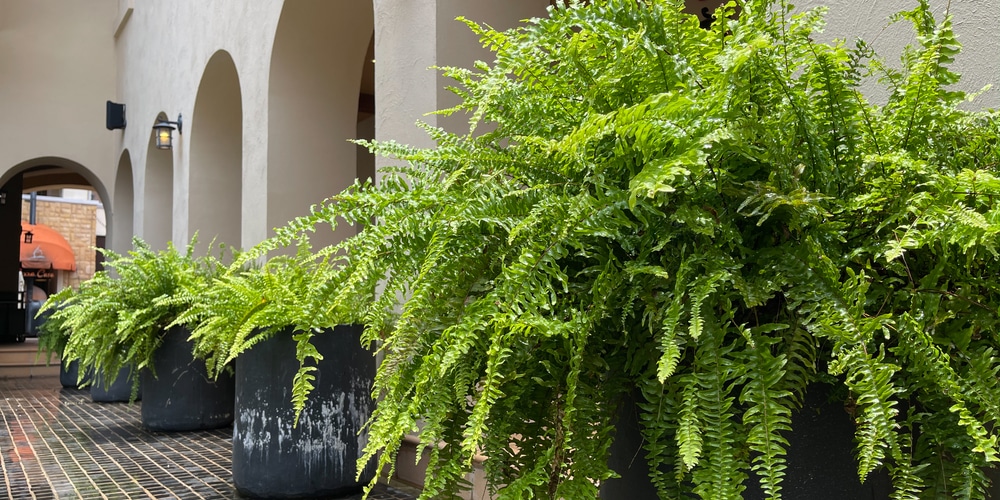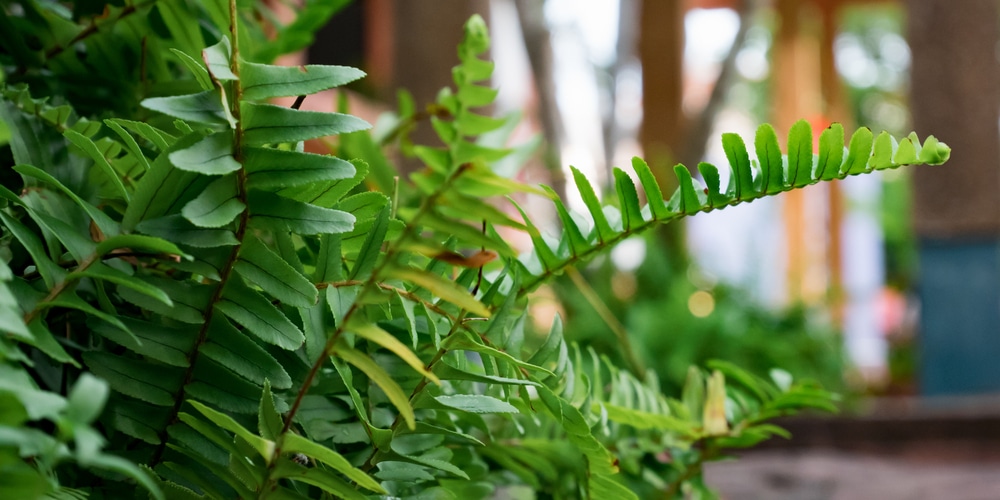The Kimberly queen fern (Nephrolepis obliterata) is an evergreen, perennial fern that is native to Australia. It gets its name from the fact that it was first found near the Kimberly region in Australia. Let’s look at Kimberly Queen Fern care requirements.
Summary info

The following is a quick summary of key points about the Kimberly queen fern.
Botanical Name: Nephrolepis obliterata
Common Names: Kimberly Queen Fern, Sword Fern
Plant Type: Perennial, evergreen fern
Flower color: Does not produce flowers
Bloom time: N/A
Mature Size: 24″–36″ tall, 24″–48″ wide
Sun requirements: Partial sun, shade
USDA hardiness zones: 9-11
Soil pH: Acidic-to-neutral
Soil Type: Moist, well-drained
Water needs: Medium
Native Area: Australia
What you need to know about the Kimberly queen fern
As an indigenous Australian species, belonging to the Nephrolepidaceae family, this fern is usually characterized by its long, dark green fronds that arch gracefully.
The sword-shaped fronds of the Kimberly queen fern that can grow up to 24-36″ (61-91cm) in length are the reason why the plant is fondly referred to as the sword fern.
Even though not so many people are aware of this, the trademarked spelling of this fern’s name is “Kimberley”, but the more popular spelling is “Kimberly”.
And while not everyone will agree with us on the correct spelling, we can all agree that the Australian Sword Fern is a popular plant throughout the world.
This plant thrives best in warmer climates and unlike other ferns such as the Dallas fern or Boston fern, this one is, thankfully, quite easier to care for.
How to care for Kimberly queen fern
Best planted in the spring, the Kimberley queen fern has a fast growth rate, as long as it’s well taken care of. Just like a majority of other ferns, this one also prefers an environment with consistent humidity and moisture.
Even though it’s not common to find such conditions in an indoor environment (for those interested in making this fern an indoor plant), the good news is that the fern acclimatizes to container growth perfectly.
All that you are required to do when growing this plant indoors is to water it often enough and offer supplemental humidity whenever necessary.
Other than planting in containers, you can also use hanging baskets to show off the long fronds of this plant. If outdoor conditions are met, then the Kimberly queen fern can also be planted in the yard.
But that’s not all. Here are the other growing requirements that you need to know about as far as caring for your Kimberly queen fern is concerned:
Light
Even though the Kimberley queen fern can tolerate direct sunlight, it thrives best under bright, indirect sunlight. That’s why placing it next to a north-facing window when growing it indoors is recommended.
If growing it outside, placing it in a spot that receives dappled sunlight or filtered shade should be ideal. Just make sure that the plant doesn’t receive too much direct sunlight.
That’s in consideration that direct sunlight can scorch its fronds, making them lose their attractive green color.
Water
When it comes to watering, this plant likes its soil to be moist at all times, but not soggy. That’s why you need to water it regularly and make sure that the pot has proper drainage to avoid waterlogging.
The best time to water this plant is when the top 1-2 inches of soil have dried out. As you may expect, the watering frequency will be highly dependent on the heat and light intensity.
Keep in mind that the Australian sword fern does not handle water with high amounts of salt, chlorine, or fluorine well. If that’s the only water that you have access to, you may need to filter it.
Soil
The ideal soil for this fern is one that is rich in organic matter and has a high moisture retention capacity. A mixture of peat moss and perlite or sand should do the trick.
As for the soil pH, the ideal range would be between 4.5 and 6.5, which is slightly acidic to neutral.
Temperature requirements
The optimal temperature range for this plant is between 60°F and 70°F (15.5°C – 21.1.°C), hence it does best in USDA hardiness zones 9-11.
You will want to avoid exposing your plant to a heat source such as a fireplace. And since it does not tolerate frost, having it stay next to an air conditioner is also not a good idea.
Fertilizer
When it comes to fertilizer, this plant is not a big feeder. Once per month during the active growing seasons (spring and summer) should be enough. Make sure to use a well-balanced liquid fertilizer for the best chances of healthy growth.
Common pests and diseases to look out for
In general, ferns are not highly susceptible to pests and diseases. However, when grown indoors, this plant may be attacked by spider mites, aphids, mealybugs, and fungus gnats. Using an insecticidal soap and neem oil should help get rid of these pests.
Proper watering practices and ensuring good air circulation around the plant should help prevent issues such as root rot.
Kimberley queen fern propagation
There are two main ways of propagating this plant, and they include:
1. Division method
The easiest way to propagate this plant is by division, which can be done in spring or autumn. Simply dig out the parent plant and divide it into smaller sections, making sure that each section has at least 3-4 fronds.
Replant the divisions in pots filled with moistened potting mix and place them in an area that offers bright, indirect sunlight. Keep the soil moist but not soggy and within a few weeks, you should see new growth.
2. Spores method
This fern can also be propagated using spores, which are found on the undersides of its fronds. To harvest them, simply place a paper bag around one or two fronds while making sure to secure it to the base.
You may need to support the frond if the weight from the bag makes it bend.
After two weeks, or thereabout, the spores will be mature (looks like brown dust) and ready to be planted. To plant them, simply sprinkle them on the surface of a tray filled with moistened sphagnum moss.
Cover the tray with its lid and maintain moisture throughout the germination process.
Once germination has started, you will see a moss-like layer forming on the surface of the media. After a couple of days, you will see small fern leaves.
At this point, you can open the lid slightly to promote aeration for better germination. After the leaves have grown into fronds, you can now remove the lid entirely.
Once the seedlings are a couple of inches tall (large enough to be handled), you can transplant them into individual pots. Make sure that the potting medium is well-drained, and see to it that the plants remain moist but not soggy.
Final thoughts
The Kimberly queen fern is a beautiful, low-maintenance plant that is perfect for both novice and experienced gardeners alike. With its lush, full foliage and tolerance to quite a wide range of growing conditions, this plant is definitely one that you will want to consider adding to your indoor garden.
So go ahead and give it a try, and you just might find that you have a new favorite plant!
Related Article: How to Prune Ferns

